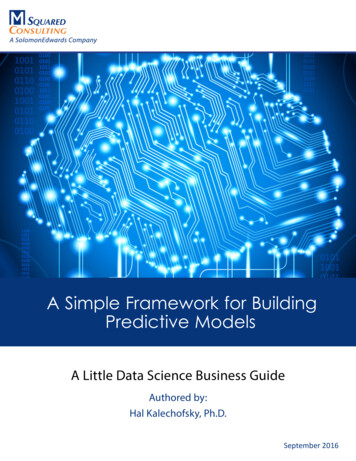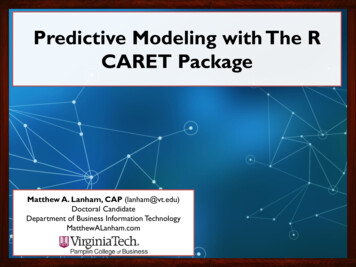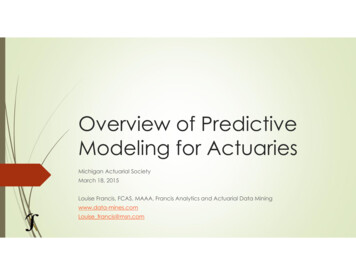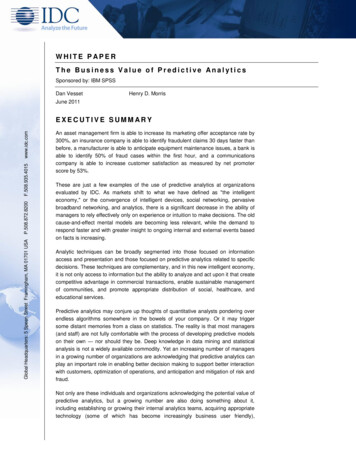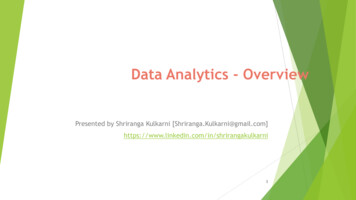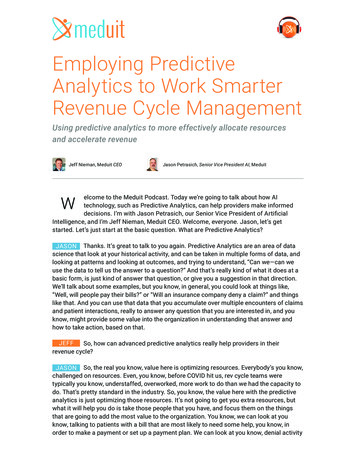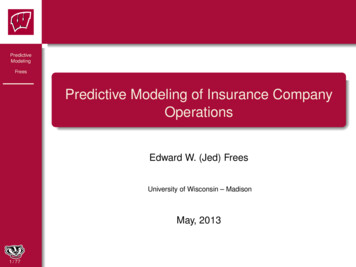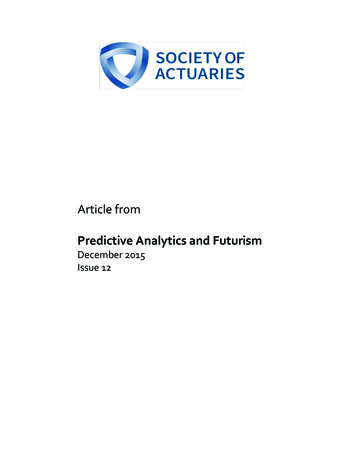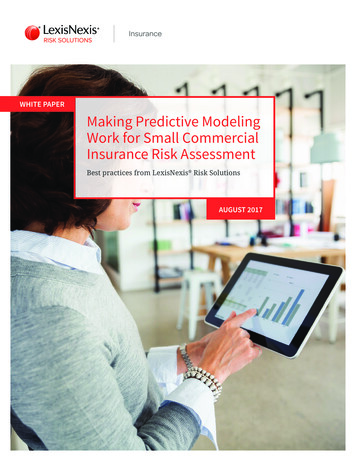
Transcription
THESCIENCEBEHIND THE PREDICTIVE INDEX How Our RevolutionaryMethodology Works Wonders 2015 The Predictive Index
Built for BusinessThe Predictive Index , or PI , is a proven methodology that allows businesses to understand thefactors driving their workforce. Scientific validation and a 60-year proven track record shows thatbusiness challenges large and small are no match for our unique approach to client education andknowledge transfer, which ensures swift adoption, direct ROI, and high impact on performancemetrics.We adhere to professional guidelines and government compliance.Our assessments and recommended practices have been developed in a manner consistent withall critical standards and guidelines. They were designed to provide a framework for determiningthe proper use of assessments and other selection procedures, as well as preventing discriminatoryemployment practices.The Predictive Index assessments and recommended practices comply with: Equal Employment Opportunity Commission (EEOC) Uniform Guidelines for the Development and Use of Personnel Selection Procedures (1978) American Psychological Association (APA) Society for Industrial and Organizational Psychology (SIOP) International Test Commission (ITC)It all started with our founder, the late Arnold S. Daniels.Arnold S. Daniels, creator of the PI Behavioral Assessment and founder of The Predictive Index, wasintroduced to assessments in the 1940’s while serving in the United States Army Air Corps. He was abombardier, navigator and gunnery officer. After flying over 30 missions before and after D-day,Daniels was assigned to partner with a psychologist who had been tasked with understandingthe make-up of successful bombing teams. Daniels was introduced to the subject of tests andmeasurements and this is where his obsession with psychometric testing began.After his discharge, Daniels educated himself in the area of workplace psychology, while brieflyattending Harvard Business School and multiple management consulting firms. Solving businesschallenges through the lens of people became Daniels’ sole mission in life. This led to the creationand initial release of the first PI Behavioral Assessment in 1955.During this time, The Predictive Index was used with thousands of clients and nearly 500 validationstudies in practically every job and industry in the known work universe. As the assessment gainedmore use in business, it received continual updates and today represents a well-established,business-relevant, and scientifically sound measure of behavioral tendencies in the workplace.2THE SCIENCE BEHIND PI
All of our assessments are scientifically validated againstpopulations large enough to be used for any job, in any industry,in any location worldwide.How The PI Behavioral Assessment WorksWe focus on the person, not the population.The Predictive Index Behavioral Assessment was created through a normative sample of thousands ofpeople. Data collected from this sample is used to identify a normal range of behavioral factor levels forthe adult working population (e.g., what is high, average, and low). Typically, benchmarked samples onlyallow you to see how someone falls on a spectrum relative to others in the working population. Whilethe PI Behavioral Assessment leverages this benchmarking methodology, it also reaches beyond typicalpeople-to-people differences to provide a lens into people’s distinct drives and needs by a comparison ofbehavioral factors.For example, even though two people may have equal levels of dominance as compared to eachother, one person may have a high level of extraversion relative to their level of dominance while theother is low in comparison. The relational difference between each person’s dominance level andextraversion level represents a very different set of drives and needs, and these differences impact howeach individual will function at their best in the workplace. Unlike many assessments, The PI BehavioralAssessment provides an especially advanced layer of insight and analysis.The insight provided allows for a true understanding of what people need to function at their best— what uniquely motivates, drives or even excites them — in comparison to the needs of others. Thisallows the identifi ation of what makes a candidate or employee “tick” before you manage themand recognize the things that will keep them motivated and working toward your overall businessobjectives.3THE SCIENCE BEHIND PI
Behavioral DrivesThe PI Behavioral Assessment predicts four primary personality constructs (see below) and twosecondary constructs (Factors E — Decision Making, and M — Response Level). These are “normal”(non-clinical) characteristics that describe, explain and predict day-to-day workplace behaviors.DominanceHIGH: Independent, assertive and self-confidenLOW: Agreeable, cooperative and accommodatingExtraversionHIGH: Outgoing, persuasive and socially-poisedLOW: Serious, introspective and task-orientedPatienceHIGH: Patient, consistent and deliberateLOW: Fast-paced, urgent and intenseFormalityHIGH: Organized, precise and self-disciplinedLOW: informal, casual and uninhibitedThe PI Behavioral Assessment provides two patterns of an individual’s workplacebehavior:1. SELFThe Self pattern is a reflection of an individual’s natural drives and needs and how they will naturallyreact in an environment or in situations.2.SELF-CONCEPTThe Self-Concept pattern reflects how an individual may be adapting their natural behaviors to theexpectations of their current work environment.SelfSelf ConceptNative Drives — “What comesnaturally” in a person’s behavior.How they believe they need toadapt to their work environment.SynthesisHow the person usually behaves inthe work environment.Comparing the Self to the Self-Concept pattern can reveal tension or synergy between an individualand their current workplace. This can be used to identify the root of observed behaviors and aid inmanaging individuals through the hire-to-retire lifecycle.4THE SCIENCE BEHIND PI
How The PI Learning Indicator WorksThe PI Learning indicator is a general, 12-minute timed cognitive ability assessment that measuresan individual’s capacity to learn quickly, grasp new concepts, adapt to changing circumstances,and understand complexity in the work place. Cognitive ability is considered to be one of the bestpredictors of training success and job performance.Conclusive research finds that when measured, specific cognitive abilities are so highly-rated thatthey represent a single underlying factor known as ‘g’ – general cognitive ability. This means thatwhen a person scores highly on a ‘g’ measure like this one, they are likely to be strong in the area ofspecific cognitive abilities, demonstrating capabilities of performing at higher levels for workplacetasks. Assessment-takers are tasked with completing as many correct answers as possible to a setof 50 questions of varying difficulty that cover:1. Numerical – 3 people fail the test. 2 people do not. How many took the test?2. Abstract - A square is split in half diagonally. Which shape results?3. Verbal – Sally laughs when the bell rings. The bell rang twice yesterday. Which of the following is true?The test-engine builds each assessment so thateach candidate experiences a unique set ofquestions, minimizing the risk of cheating andcreating the possibility for a second assessment.Instead of “good” vs. “bad’ scores, it is best to thinkof PI Learning Indicator scores in terms of fit witthe cognitive requirements of the role. A “good fitshows an increased likelihood of success throughtraining and job performance, while weaker fit mayindicate difficulties in getting up- o-speed quickly,catching on or figuring things out. It is best o startby identifying a recommended target score based on the role and work environment. The level of jobcomplexity and organizational factors such as the speed of business and structure impact help shapethe cognitive demands of the job and are considered when identifying a recommended target score.Example Scoring Scenario5THE SCIENCE BEHIND PI
You can rely on our assessments.They are reliable.Test-retest reliability for the PI Behavioral Assessment has been evaluated in multiple studies withresults showing strong stability in intervals of two weeks to four years and adequate reliability fromretest intervals of five to eight years. Internal consistency reliability has been evaluated recently inthree studies with an average internal consistency reliability between .82 and .87. The PI LearningIndicator has been evaluated multiple times over the past four years for test-retest reliability aswell with studies showing test-retest parallel form estimates between 0.71 and 0.81. All estimates forPI assessments exceed the lowest boundary of acceptability which is .70.They are scientifically valid.Multiple construct validation studies have been conducted through the years comparing behavioralassessment factors to relevant scales in well-established normal personality assessments like the16PF and NEO PI-R. These studies have shown the strong convergent validity necessary to claimthat the PI Behavioral Assessment is construct-valid. For example, the correlation between theassessment’s Dominance (A) factor and the 16PF’s Independence factor was .47 (p .01) and thecorrelation between the Extroversion (B) factor and the NEO PI-R Extroversion scale is .63. Strongconcurrent validation evidence with similar assessments (E.g., the Wonderlic, Raven’s ProgressiveMatrices, and Cubix Logix) shows that the PI Learning Indicator provides a solid measure of cognitiveability.They predict job performance.The PI Behavioral Assessment has been investigated in nearly 500 criterion-related validity studiessince September of 1976 across almost all jobs and countries. This body of evidence supports the factthat the assessment is indeed consistently related to important workplace outcomes such as tenure,turnover, sales and customer satisfaction. Two recent meta-analyses show that it predicts overall jobperformance, tenure, sales performance and counterproductive behavior.The assessment is bias free. In every study in the last two decades, it has been shown that scores donot differ on the basis of age, gender or ethnicity. In addition, there is no evidence to indicate that itsinclusion in a company’s personnel selection system — either in a compensatory or “multiple-hurdle”selection model — results in adverse impact against any protected class when examining adverseimpact via the four-fi ths rule, Adverse Impact (AI) Rule or the “two Standard Deviations” rule.The PI Learning Indicator was built following strict standards of the APA (American PsychologicalAssociation), SIOP (Society for Industrial and Organizational Psychologists) and the ITC (InternationalTest Commission).6THE SCIENCE BEHIND PI
When paired together, the PI Behavioral Assessment and Learning Indicator can increase yourchances of predicting on-the-job performance by eight times!The experience is simple.The PI Behavioral Assessment is a brief (6.5 minutes on average), untimed, free-choice (as opposedto forced-choice) assessment that presents respondents with a list of adjectives and asks them toidentify which ones fit them and their current role. The assessment is available in multiple formats(paper, online, mobile) in more than 70 languages, including English Braille.The PI Learning Indicator determines a general measure of cognitive ability through the delivery ofa 12-minute timed assessment format that presents respondents the opportunity to respond to upto 50 multiple choice questions. The score of the PI Learning Indicator is calculated simply by thenumber of correct answers provided in the time allotted. The assessment is available online and canbe taken in more than 70 languages.Our science gets better with age.The Predictive Index Science team and its solutions have continuously evolved since 1955. PImaintains a Science Advisory Board staffed with university professors, I/O psychologists, and othersubject matter experts in psychometrics. The board regularly reviews and evaluates our science andmethodology so we can continue to build on the well-established foundation and history that wehave, as well as our future.Learn more about the science behind The Predictive Index here:www.predictiveindex.com/science 2015 The Predictive Index
16PF and NEO PI-R. These studies have shown the strong convergent validity necessary to claim that the PI Behavioral Assessment is construct-valid. For example, the correlation between the assessment's Dominance (A) factor and the 16PF's Independence factor was .47 (p .01) and the

